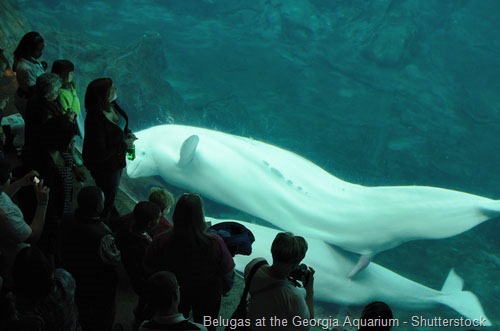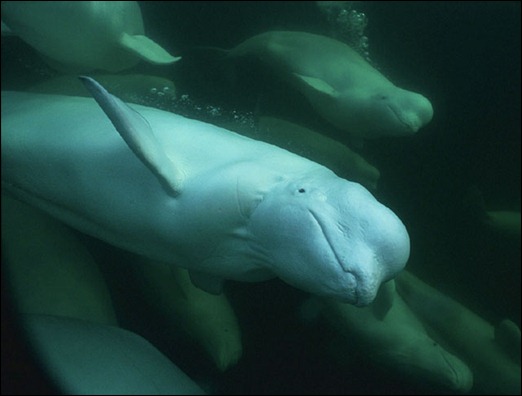Bernie, Belugas and the Home Depot
“Whew,” Bernie Marcus mutters to himself. “As long as everyone’s talking about SeaWorld, they won’t be coming after my Georgia Aquarium. At least not for the…

“Whew,” Bernie Marcus mutters to himself. “As long as everyone’s talking about SeaWorld, they won’t be coming after my Georgia Aquarium. At least not for the…
It’s being hailed as a very significant victory for the anti-captivity movement. Today, the U.S. government’s National Oceanic and Atmospheric Administration (NOAA) denied the Georgia Aquarium’s…
There’s lots of talk this week about a “talking” beluga whale who died five years ago at a U.S. Navy facility. And it’s all grist to…
The following extensive notes are from Naomi Rose at Humane Society International, who will be testifying at the permit hearings. A complete pdf of these notes, along with queries for the aquarium and the National Marine and Fisheries Service, which authorizes permits, can be downloaded here, along with information for obtaining complete source materials.
These are questions that can be posed to the Georgia Aquarium about their capture of 18 beluga whales for import into the United States:
All the permit application materials regarding the Georgia Aquarium’s beluga import permit application are available at the website of the federal NOAA/NMFS agency. You can submit comments there. And you can contact the the Georgia Aquarium as follows:
(Part Seven of this series.) Gaining a permit to bring dolphins and whales into captivity involves negotiating a thicket of legal, moral and public relations issues. The captivity hasn’t tried this for almost 20 years. If the Georgia Aquarium succeeds with the belugas they’ve captured in Russia, it will open the door to a flood of new imports for the marine zoos and circuses. At a public hearing, Naomi Rose of Humane Society International will be arguing the case for returning those belugas to their homes and families.
(Sixth in the series.) When she was two years old, a lonely orphan beluga began making friends with fishermen and tourists in Chedabucto Bay, Nova Scotia. But as she became habituated to humans and boats, she was injured several times by propellers. And instead of learning to be part of a beluga family, she was learning to sound like a propeller and to mimic the human children who were calling out to her.
(Fifth in our series about beluga whales in captivity.) They’re cute, charming, chatty, curious and all-round delightful. And that’s their problem – it makes them prime targets of the captivity industry that can make money by putting them on show. Dr. Lori Marino is a neuroscientist who specializes in the cognitive abilities of whales and dolphins, elephants, primates and other animals. We asked her about the brains and smarts of belugas.
(Fourth in a series on belugas in captivity.) Samantha Berg worked with the belugas at SeaWorld in the 1990s. Today, she is an outspoken critic of the captivity industry and a frequent expert guest on radio and TV shows. We talked with her about what it’s like for belugas in captivity, about their life in the wild, and about her time at SeaWorld with Shadow, Spooky, A.J. and Bandit. (While belugas in the wild can live well into their sixties, all four of the ones she knew at SeaWorld have since died.)
(Third in a series on belugas in captivity.) One day in 1861, 11-year-old Sarah Putnam wrote in her diary: “I went again to the Aquarial Gardens and there we saw the Whale being driven by a girl. She was in a boat and the Whale was fastened to the boat by a pair of reigns and a collar, which was fastened round his neck. The men had to chase him before they could put on the collar.” What Sarah had seen that day was one of the first beluga whales to be captured and put on display in the United States.
(Second in a series on belugas in captivity.) Tales of belugas stretch back thousands of years. A 6,000-year-old rock carving in northwest Russia shows a woman, perhaps a shaman, communicating with a beluga whale. A Medieval Christian legend tells of a white horse being resurrected as a beluga. But today, many scientists believe that belugas may be our best hope when it comes to trying to establish language-based communication with other animals.

The captivity industry’s assault on the world’s cutest whales The Georgia Aquarium has applied for a permit to import 18 beluga whales from Russia into the…
By law, marine mammals can only be held in captivity and put on display at zoos and marine circuses if they are doing this for “educational…
The Georgia Aquarium is planning to capture 18 beluga whales from where they live in the Sea of Okhotsk in eastern Russia, and fly them halfway around the world to put them on display in Atlanta. Their explanation for doing this would be hilarious if it were not so sad and not such an unconscionable abuse of highly intelligent animals.